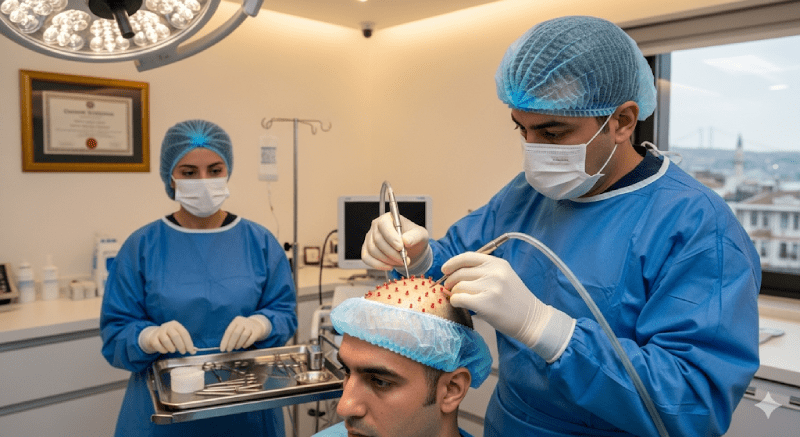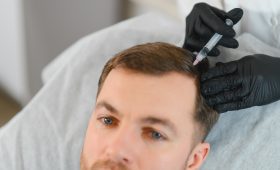What Are 3000 and 4000 Grafts Hair Transplant?
A 3000 and 4000 grafts hair transplant is a procedure where hair follicles are taken from the donor area, using methods like FUE or DHI, and transplanted to bald or thinning areas. Since 1 graft usually contains 2-3 hair strands, these numbers of grafts mean a very dense transplant. 3000 grafts are generally sufficient for individuals with a moderate level of hair loss, while 4000 grafts are preferred for covering larger areas or achieving a higher density. These procedures aim to offer a permanent and natural solution, thereby boosting individuals’ self-confidence.
How Much Do 3000 Grafts Hair Transplant Cost in Turkey?
The prices for a 3000 grafts hair transplant in Turkey generally range from 1,500 to 3,000 Euros, depending on the clinic, the surgeon’s experience, the technology used, and the package’s content. This price is much more economical compared to prices in European and North American countries. The price usually includes a pre-operative consultation, the surgery itself, post-operative check-ups, medications, shampoos, and sometimes accommodation and transfer services.
How Much Do 4000 Grafts Hair Transplant Cost in Turkey?
The cost of a 4000 grafts hair transplant in Turkey can be slightly higher than a 3000 grafts procedure. The price range generally varies between 1,800 and 4,000 Euros. This increase is associated with a longer procedure time, the transfer of more hair follicles, and more effort from the surgeon. Thanks to all-inclusive packages, patients’ exposure to additional costs during this process is minimized, which makes budget planning easier.
What Do the Prices Include and Exclude?
The content of hair transplant packages varies from clinic to clinic. Generally, packages cover basic expenses such as the surgery fee, anesthesia, medications, post-operative care products, a special hat, and a bandage. Some “all-inclusive” packages may also include airport transfers, 2-3 nights of accommodation, and a translator service for English speakers. Airfare, passport, and visa expenses are usually covered by the patient and should therefore be added to the total budget.
What Is the Reason for Affordable Prices in Turkey?
There are several main reasons for the affordable hair transplant prices in Turkey. The main reasons are the lower general living expenses, rent, and labor costs compared to Western countries. In addition, government incentives for health tourism and intense competition in the sector allow clinics to keep their prices low. This offers an economic treatment option without sacrificing quality.
Which Methods Are Used for Hair Transplant?
Hair transplant centers in Turkey use the most modern and effective methods such as FUE (Follicular Unit Extraction) and DHI (Direct Hair Implantation). FUE involves taking hair follicles one by one and transplanting them after opening channels, while the DHI method uses a special pen (Choi Pen) to perform the transplant directly without opening channels. Both methods yield natural and successful results; the appropriate method is determined based on the patient’s condition.
Are 3000 Grafts Enough?
3000 grafts are generally sufficient for individuals with a moderate level of hair loss, especially those experiencing thinning at the hairline or on the crown area. This number of grafts is ideal for hairline restoration and providing density among existing hair. The most suitable number of grafts will be determined by your surgeon after detailed pre-operative analyses and consultations.
Who Is 4000 Grafts Suitable For?
4000 grafts are suitable for individuals who have hair loss in a wider area or aim for a higher hair density. It is generally preferred for people with a Norwood scale hair loss level of 4 or 5. This number of grafts provides an effective solution for both recreating the hairline and covering a large section of the scalp.
How Long Does the Hair Transplant Procedure Take?
A 3000 grafts hair transplant procedure generally takes 6 to 8 hours, while a 4000 grafts procedure can take 8 to 10 hours. The duration of the procedure varies depending on the method used, the condition of the donor area, and the surgeon’s speed. Short breaks are given during the procedure to ensure the patient is comfortable, which helps the process go more smoothly.
What Is the Post-Operative Recovery Process Like?
It is normal to experience swelling and redness for the first few days after the surgery. The scabs in the transplanted area fall off within the first 10 days, and the hair follicles begin to settle. The full recovery process usually takes 1 year. It is a common situation for the hair to fall out and start growing again (shock shedding) within the first 3 months.
Why Are Doctors in Turkey So Experienced?
Turkey is a leader in health tourism and has a worldwide reputation for hair transplantation. Thanks to the intense flow of patients, surgeons in Turkey get the opportunity to perform a large number of hair transplant operations. This allows them to gain extensive experience on different hair types and hair loss conditions and to continuously improve their surgical skills.
Is Hair Transplant Safe in Turkey?
Hair transplant in Turkey is extremely safe when the right clinic and an experienced surgeon are chosen. Many Turkish clinics have international accreditations (such as JCI, ISO) and provide services at high hygiene standards. Close monitoring of patients during pre- and post-operative processes minimizes the risk of complications.
How Long Does Post-Operative Pain Last?
Since the hair transplant procedure is performed under local anesthesia, the patient does not feel pain during the procedure. It is normal to feel mild pain or discomfort for the first few days after the surgery, and this can be easily controlled with painkillers prescribed by the doctor. The pain usually disappears completely within a few days.
Do the Transplanted Hairs Look Natural?
Yes, when done with the right techniques and by an experienced surgeon, the transplanted hairs look extremely natural. The surgeon pays attention to the natural angle and direction of hair growth during the transplant. This ensures that the transplanted area gains a look that is harmonious with the other hairs and is difficult to notice.
What Is Shock Shedding and When Does It Occur?
Shock shedding is the temporary shedding of transplanted hair within 2-8 weeks after the hair transplant procedure. This is a normal part of the process where hair follicles adapt to their new location and is not a cause for concern. The roots of the shed hairs remain in the skin and start growing again after 3-4 months.
What Medications Are Used Before and After the Surgery?
Before the surgery, blood-thinning medications and some vitamin supplements are usually stopped. After the surgery, the doctor prescribes painkillers, antibiotics, and anti-edema medications. In addition, supplements containing biotin, zinc, and other vitamins may be recommended to strengthen the hair follicles.

Does a Scar Remain After Hair Transplant?
With hair transplant performed using the FUE method, a prominent scar does not usually remain in the donor area. Since the hair follicles are taken one by one, only small, dot-shaped scars form, and these become invisible when the hair grows. The risk of scarring is even lower with the DHI method. This makes hair transplantation extremely successful cosmetically.
What Do Packages for Patients From Abroad Offer?
The packages offered for patients coming from abroad are usually very comprehensive. These packages may include the surgery fee, 1-3 nights of accommodation, airport transfers, pre- and post-operative medications, and personal care products. Some clinics also offer extra services such as city tours or translation services to increase the comfort of patients.
Which Season Is Suitable for the Surgery?
Hair transplant surgery can be performed in any season. However, it is important to avoid excessive sun exposure and sweating during the summer months. Therefore, spring or autumn months are generally preferred for a more comfortable recovery process. As long as the clinic’s instructions are followed, any time of the year is suitable for the procedure.
When Do the Results of the Hair Transplant Become Apparent?
The final results of the hair transplant usually become apparent after 1 year. Hair shedding (shock shedding) is experienced within the first 3 months. New hairs start to grow from the 4th month, and 50-60% of the results are visible at 6 months. After the 9th month, the hairs thicken, and they reach their final appearance within 12-18 months.
How Should Hair Care Be After Hair Transplant?
For the first few days after the surgery, special shampoos and lotions recommended by the clinic should be used. The first wash is usually done at the clinic. It is important to protect the transplanted area from excessively hot or cold water, to wash it gently, and not to rub it. Keeping the scalp moist and strictly following the doctor’s instructions are essential for a healthy recovery.
Can I Travel After Hair Transplant?
Yes, you can usually travel after resting for 1-2 days after the hair transplant. However, you should be careful to protect your head during long flights or car trips. Your clinic will give you special advice based on your travel plan. It is important to protect your head from impacts and to avoid exposure to excessively hot/cold weather.
What Is the Main Difference Between 3000 and 4000 Grafts?
The main difference between 3000 and 4000 grafts is the size of the area to be transplanted and the hair density to be achieved. 3000 grafts are sufficient for those who have less hair loss and want to focus on specific areas like the hairline or the crown area. 4000 grafts are more suitable for those who want to cover a wider area or achieve a higher density.
Do the Transplanted Hairs Fall Out?
The transplanted hairs are permanent because they are usually taken from the donor area (the nape area) which is genetically resistant to hair loss. Even if a temporary shedding called “shock shedding” occurs, the hair roots remain intact and grow back. Therefore, the transplanted hairs maintain their permanence for a lifetime.
What Happens If the Hair Transplant Is Not Successful?
The success rate of hair transplant is quite high when it is done by an experienced surgeon and with the right techniques. However, in rare cases, the transplant may fail. In this situation, you should get information about your clinic’s revision surgery policy. Some clinics may offer a free revision in case of failure after the first surgery.
What Sports Can Be Done After Hair Transplant?
For the first few days after the surgery, heavy exercises, sports that cause sweating, and swimming should be avoided. Light walks can be started in the first week. It is generally necessary to wait 4-6 weeks for heavy lifting and sports that require high effort. It is recommended to wait 2-3 months for risky activities such as full-contact sports.
Can a Hat Be Worn After Hair Transplant?
A specially designed bandage or a loose hat can be worn for the first few days after the surgery. However, hats that will put pressure on the transplanted area and prevent it from breathing should be avoided. Normal hats can be worn after 10 days, but care should still be taken to avoid friction or pressure.
Who Is the Best Candidate for Hair Transplant?
The best candidate for hair transplant is a person who has enough donor hair, is in good general health, and whose hair loss has stopped for a year. In addition, people who have realistic expectations from the transplant and can follow the post-operative instructions are the most suitable candidates.
How Should Smoking and Alcohol Consumption Be After Hair Transplant?
Smoking and alcohol should not be consumed for at least 1 week before and after the surgery as they adversely affect blood flow and delay wound healing. If possible, avoiding them for a longer period will speed up the recovery process. Alcohol has a blood-thinning effect, so it can increase the risk of bleeding.
How Are Post-Operative Check-Ups Done?
Clinics in Turkey usually set up online follow-up systems for patients coming from abroad. Patients send photos of the transplanted area to their doctors at certain intervals after the surgery. Doctors can thus monitor the recovery process remotely and provide advice when necessary.
When Can Hair Be Cut After Hair Transplant?
It is generally recommended to wait for the first month to cut your hair after the surgery. The first cut should be done with scissors. It is safer to wait 3-4 months for the donor area to heal completely and be suitable for using a shaving machine. During this time, the hair follicles will have completely settled and strengthened.
What Are the Factors That Increase Hair Transplant Success?
The factors that increase hair transplant success include the surgeon’s experience, the technological infrastructure of the clinic, the patient’s adherence to pre- and post-operative instructions, a healthy diet, and avoiding smoking and alcohol. Having a good donor area also directly affects the success rate.
Why Is There a Price Difference Between 3000 and 4000 Grafts?
The price difference is due to the increase in the procedure time, the effort exerted by the surgeon, and the number of materials used. A 4000 grafts procedure takes longer and requires more attention than a 3000 grafts procedure. This naturally leads to an increase in cost.
Why Are Hair Transplant Prices in Other Countries Higher Than in Turkey?
The main reasons for the high hair transplant prices in Western countries are high labor costs, expensive hospital operating expenses, and high tax rates. These costs are lower in Turkey, which allows surgeons to keep their prices more competitive.
In Which Situations Should a Doctor Be Consulted After Hair Transplant?
You should immediately contact your clinic in situations such as excessive bleeding, severe pain, high fever, an unexpected swelling in the transplanted or donor area, or signs of infection (redness, discharge). Although such situations are rare, early intervention is important.



